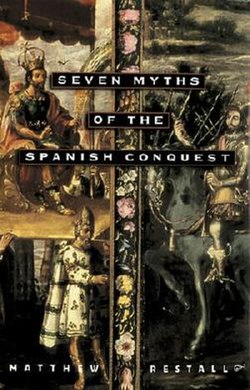 Cover of the 2003 OUP hardback edition. The design shows a photo reproduction of two portions of the late 17thC painting El encuentro de Cortés y Moctezuma, attributed to Juan Correa, held in the collection of the Banco de México | |
| Author | Matthew Restall |
|---|---|
| Cover artist | Mary Belibasakis (jacket design) |
| Publisher | Oxford University Press |
Publication date | 2003 |
| Media type | Print hbk (2003), pbk (2004) |
| Pages | xix, 218pp.: ill., 1 map. |
| ISBN | 0-19-516077-0 |
| OCLC | 51022823 |
| 980/.013/072 21 | |
| LC Class | F1230 .R47 2003 |
Seven Myths of the Spanish Conquest is a 2003 work by ethnohistorian Matthew Restall in which he posits that there are seven myths about the Spanish colonization of the Americas that have come to be widely believed to be true. Working within the tradition of New Philology, Restall questions several notions which he claims are widely held myths about how the Spanish achieved military and cultural hegemony in Hispanic America. The book grew from undergraduate lectures at Penn State University. [1] The book has been published in Spanish and Portuguese translations.